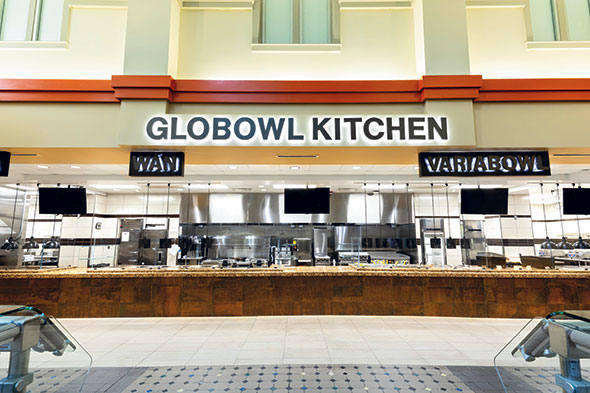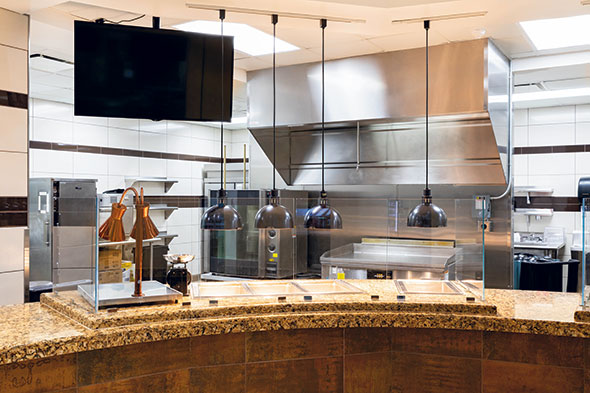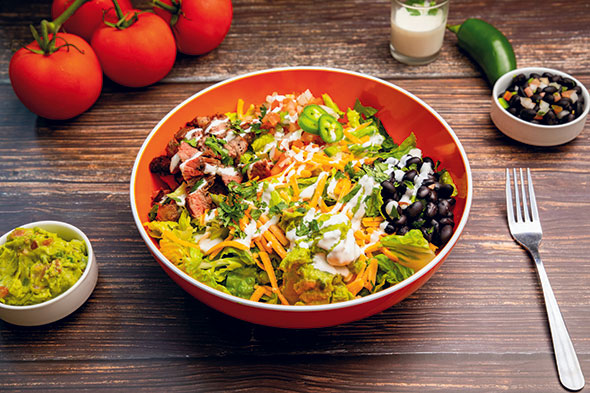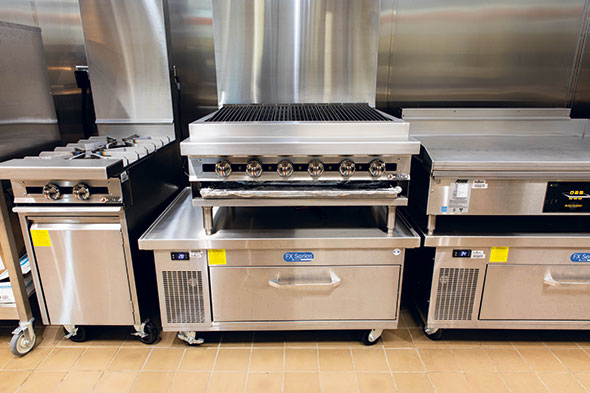Globowl Kitchen and an adjacent platform, Farms, bring new flavors to customers at Virginia Tech’s Owens Dining Center. Both also offer menu favorites that generations of students will remember long after they’ve graduated.
 Globowl Kitchen allows students to customize many of their menu items while watching the culinary action.
Globowl Kitchen allows students to customize many of their menu items while watching the culinary action.
Built in 1940, Owens Hall was named after a university mess steward J.J. “Pops” Owens. Owens Food Court opened in 1991 and contains 12 restaurants serving American and international cuisines. It’s located inside Owens Dining Center. The university gave Owens a facelift in 2006. In 2019 the food court introduced Globowl Kitchen, a renovation and refresh of the dining concept and design. A separate branded concept, Farms, was also introduced.
“The larger diversity increasingly coming to campus is pushing our culinary envelope,” says Ted Faulkner, director of Dining Services. “Our goal is to satisfy their tastes and offer options that provide a sense of comfort and home all the while meeting their dietary goals. Globowl Kitchen and Farms do that.”
“Owens Food Court looked very tired and dated,” says Brian Grove, associate director of Dining Services. “For several years, sales had declined due to newer venues on campus, combined with its outdated interior design and static menu.”
When researching concepts for this front-line renovation, the Globowl Kitchen and Farms project team, which included Faulkner, Grove and Lauren Snelson, assistant director of Owens Dining Center, visited many restaurants that offer authentic cuisine. The group received input from Dining Services’ student advisory committee and other campus community members to determine which trends would be most appealing to students.
Globowl Kitchen contains five front-line platforms: Dish, Ciotola, Wăn, Tazón and Variabowl. The concepts for Globowl Kitchen and Farms had to be constructed within a set amount of space in Owens Food Court and make use of the existing hood system. Globowl Kitchen and Farms resides alongside existing concepts that weren’t refreshed: Frank’s Deli, Pops (Philly cheesesteaks and burgers), Sweets, Freshëns and a self-service coffee area. Other Owens Food Court areas received renovations in years past: a salad bar in 2018; the central commissary that supports the food court and Hokie Grill in 2017, and the dining area received a paint refresh and seating overhaul in 2014.
 Heat lamps maintain the temperature of menu items at Dish.
Heat lamps maintain the temperature of menu items at Dish.
In addition to maximizing menu variety, project designers wanted to improve service efficiency and the overall dining experience.
“With bowl concepts, customers get to customize their orders, selecting proteins, vegetables, rice, noodles and garnishes,” Faulkner says. “Rather than using a rotating menu from week to week, we are replicating the use of several ingredients in small batch cooking. Because customers can use these ingredients to customize their own dishes, they have many options if they wish.”
 Customers make bowls at Tazón, the Mexican platform.
Customers make bowls at Tazón, the Mexican platform.
Another project goal was to improve speed of service for an anticipated growth in the number of guests frequenting Owens Food Court. Culinary staff put orders together in an assembly line process, so customers move through the service lines in 15 to 20 seconds. Students rarely wait in line for more than 45 seconds.
The refreshed operation also contributes to labor efficiency. Platforms require one or two staff members versus four or five, which the previous, prerenovated stations required. “This year we have 1,000 fewer staff hours, and labor is down 1.6 percent. And we’re up 20.4 percent in revenue growth,” Faulkner says.
Menu Preparation
After food for Globowl and Farms arrives at Owens, staff bring it to refrigerated and dry storage in the commissary kitchen. They remove ingredients from storage and take them either to stations in the commissary kitchen for preparation or to the Globowl platforms. Staff bring food from the commissary kitchen to the platforms as necessary for continuous production.
The commissary kitchen contains steam-jacketed kettles, combi ovens, a smoker, a chargrill, a flattop and tilt skillets.
On the front line, which contains Globowl’s five platforms behind 70 feet of quartz countertop, customers can watch staff prepare menu items and interact with them as they make selections. To construct this line, two large columns were removed to enhance the floor space and sightlines, and create additional queues for guests to order. During construction, the project team discovered that the columns were semi load bearing, requiring the installation of beams to reinforce the ceiling.
“Because the concepts offer students so many choices, they’re taking advantage of the variety and being very creative about their selections,” Snelson says. “We’ve introduced international flavors students can’t find anywhere else on campus.” Dish offers carved proteins and home-cooked menu items such as vegetables, meatloaf and rotisserie chicken. Staff prepare menu items in a double-stacked steamer, a pasta cooker, quick-speed oven, rotisserie and griddle. An undercounter refrigerator and warmers hold ingredients at proper temperatures throughout service periods. Hot wells hold menu items, with the exception of the carved proteins.
Ciotola, a platform featuring Italian cuisine, contains a two-door refrigerator, a glass ceramic heated display merchandiser, a pasta cooker and a food warmer. Customers select their protein, noodles and sauces. Staff heat bread in a high-speed oven. “Chicken parmesan is so popular on campus that students have created their own emoji for the dish,” Snelson says. “We run an annual chicken parmesan special event, last year setting a campus record by selling 2,881 servings in a single day from this venue.”
 A bowl at Variabowl includes a grain/greens base and a protein, toppings and sauces.
A bowl at Variabowl includes a grain/greens base and a protein, toppings and sauces.
The most popular platform, Variabowl, features weekly rotating themed menus. Themed offerings include Mediterranean, Korean, Thai and Indian cuisine. Refrigerated drawers and an upright display refrigerator visible to customers hold ingredients. Staff prepare menu items such as tandoori chicken and lamb with the support of a steam griddle, as well as falafel in a fryer and Mediterranean chicken on a chargrill. Hot food wells hold the menu items for service.
 A range, chargrill and flattop griddle support production in Variabowl.
A range, chargrill and flattop griddle support production in Variabowl.
Wăn contains a wok range, four induction woks and rice warmers that staff use to prepare Szechuan pork stir-fry and kung pao vegetable stir-fry. “We kept General Tso’s chicken from the previous unit’s menu because it is so popular,” Snelson says. “We serve nearly 1,200 portions a day of this menu item.”
Drop-in hot and cold wells display Mexican cuisine at Tazón. Staff take ingredients from a refrigerated rail to prepare burritos and burrito bowls. Staff use four sandwich grills to heat quesadillas. Refrigerated and heated drop-in wells hold menu items for service.
The project also added Farms, which sits adjacent to Globowl and has its own interior style to distinguish it as a stand-alone concept. Farms, previously known as Farms & Fields, features sustainable, organic and locally sourced ingredients. Many ingredients come from Homefield Farm, a student-run organic operation 10 miles west of the campus. The farm’s partnership between Dining Services and the agriculture program produced 55,000 pounds of food for campus dining centers last year. The platform contains an upright refrigerator, undercounter refrigerator, a prep cooler, an ice cream freezer, a food warmer, a panini press and a glass ceramic heated display unit. Popular menu items include Tuscan pesto chicken and Cuban paninis.
The Owens Food Court refresh also added more refrigerated and ambient merchandising cases for grab-and-go options and positioned them for quicker customer access. The cases contain menu items from various platforms and sit on either side of the cashier stations. They are branded with Dining Services’ “Grab & Gobble” labels that appear on grab-and-go menu items offered throughout campus.
The results of the Owens Food Court remodel are impressive. “Owens has brought in $760,000, or 20.3 percent more in sales, compared to the fall semester a year ago,” Faulkner explains. “The average check went up 75 cents from $8.80 to $9.55, an 8.6 percent increase. Owens captured 32 percent of the campus’s new business transactions. In addition, Owens had 45,000 more transactions in the fall semester.”
Key Players
- Owner: Virginia Tech, Blacksburg, Va.
- Director of Dining Services: Ted Faulkner
- Associate director of Dining Services: Brian Grove
- Associate director of Dining Services: Ben Marks
- Assistant director for Owens Dining Center: Lauren Snelson
- Executive chef: James Zeisler
- Architect: Colley Architects P.C., Blacksburg, Va.
- Interior design: Virginia Tech Dining Services staff and Colley Architects
- Foodservice consultants: Virginia Tech Dining Services staff
- Equipment dealers: Factory Direct Food Service Equipment, US Foods, Crest Food Service Equipment, Douglas Equipment, Clark Food Service Equipment
- Construction: W.M. Jordan Co., Richmond, Va.
About the Project
- Virginia Tech: Enrolls 36,000 students
- Owens Food Court: Renovation and redesign of the backline and servery
- Opened: August 21, 2019
- Size: 4,700 sq. ft.
- Seats: 700
- Hours: 7:30 a.m. to 9 p.m., Mon. through Thurs.; 7:30 a.m. to 8 p.m., Fri.; 10:30 a.m. to 8 p.m., Sat.;
10:30 a.m. to 9 p.m., Sun. - Platforms: Farms (sustainable, organic, local); Dish (American comfort food); Ciotola (Italian): Wăn (Asian); Variabowl (themed menus once a week); Tazón (Mexican) Popular menu items: Bam bam shrimp bowls, chicken parmesan and General Tso’s chicken.
- Staff at Owens: 200, including salaried, wage and student staff
- Daily covers/transactions: 4,400
- Average check: $9.62
- Total annual sales, projected: $9.5 million
- Total project cost: $1.1 million
- Equipment investment: $149,000
- Website: dining.vt.edu



